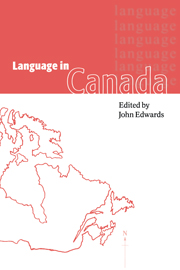Book contents
- Frontmatter
- Contents
- List of figures
- List of maps
- List of tables
- Notes on contributors
- 1 Canada
- Introduction
- 1 The foundations
- 2 The fading Canadian duality
- 3 Official bilingualism: from the 1960s to the 1990s
- 4 Official multiculturalism
- 5 Language in education: bridging educational policy and social psychological research
- 6 Aboriginal languages: history
- 7 Aboriginal languages: current status
- 8 French: Canadian varieties
- 9 French in Quebec
- 10 French in New Brunswick
- 11 French outside New Brunswick and Quebec
- 12 English: Canadian varieties
- 13 English Quebec
- 14 The teaching of international languages
- 15 French immersion in Canada
- 16 Language in Newfoundland
- 17 Language in Prince Edward Island
- 18 Language in Nova Scotia
- 19 Language in New Brunswick
- 20 Language in Quebec: aboriginal and heritage varieties
- 21 Language in Ontario
- 22 Language in Manitoba
- 23 Language in Saskatchewan: Anglo-hegemony maintained
- 24 Language in Alberta: unilingualism in practice
- 25 Language in British Columbia
- 26 Language in the Northwest Territories and the Yukon Territory
- Index of names
- Index of language families, languages, dialects
- Index of subjects
14 - The teaching of international languages
Published online by Cambridge University Press: 18 February 2010
- Frontmatter
- Contents
- List of figures
- List of maps
- List of tables
- Notes on contributors
- 1 Canada
- Introduction
- 1 The foundations
- 2 The fading Canadian duality
- 3 Official bilingualism: from the 1960s to the 1990s
- 4 Official multiculturalism
- 5 Language in education: bridging educational policy and social psychological research
- 6 Aboriginal languages: history
- 7 Aboriginal languages: current status
- 8 French: Canadian varieties
- 9 French in Quebec
- 10 French in New Brunswick
- 11 French outside New Brunswick and Quebec
- 12 English: Canadian varieties
- 13 English Quebec
- 14 The teaching of international languages
- 15 French immersion in Canada
- 16 Language in Newfoundland
- 17 Language in Prince Edward Island
- 18 Language in Nova Scotia
- 19 Language in New Brunswick
- 20 Language in Quebec: aboriginal and heritage varieties
- 21 Language in Ontario
- 22 Language in Manitoba
- 23 Language in Saskatchewan: Anglo-hegemony maintained
- 24 Language in Alberta: unilingualism in practice
- 25 Language in British Columbia
- 26 Language in the Northwest Territories and the Yukon Territory
- Index of names
- Index of language families, languages, dialects
- Index of subjects
Summary
When Canada launched a new era of social policy with its 1971 proclamation of multiculturalism within a bilingual framework of two official languages (English and French), it did not take long for the inherent ambiguities and tensions to erupt into public debate. In particular, Quebec was unhappy with the multicultural policy, which was interpreted by some as a federal plot to reduce the status of Quebec culture to one among the many others that comprised what federal politicians were fond of calling the ‘Canadian mosaic’. It was also unclear what status languages other than English and French would hold. Ethnocultural communities, particularly in the prairie provinces, argued strongly that a multicultural policy that did not include financial and institutional support for multiple language promotion was vacuous. The status of aboriginal languages was also unclear; while not ‘official’ languages, they clearly had a different status from those of more recently-immigrated groups, particularly since many aboriginal varieties were seriously endangered.
This chapter focuses on the evolution of public policy during the past twenty-five years in relation to what have come to be termed ‘international’ or ‘heritage’ languages – namely, those used in Canada other than French, English and aboriginal languages. The term ‘heritage language’ is commonly used although, in 1994, the Ontario government replaced it with ‘international language’, on the grounds that ‘heritage’ connotes learning about past traditions rather than acquiring language skills that have significance for children's overall educational and personal development.
- Type
- Chapter
- Information
- Language in Canada , pp. 293 - 304Publisher: Cambridge University PressPrint publication year: 1998
- 4
- Cited by



